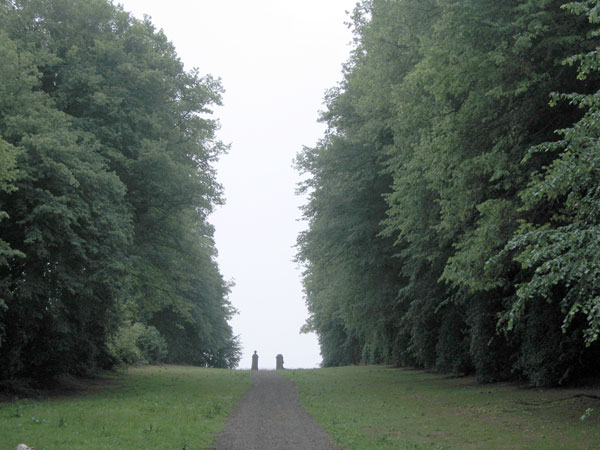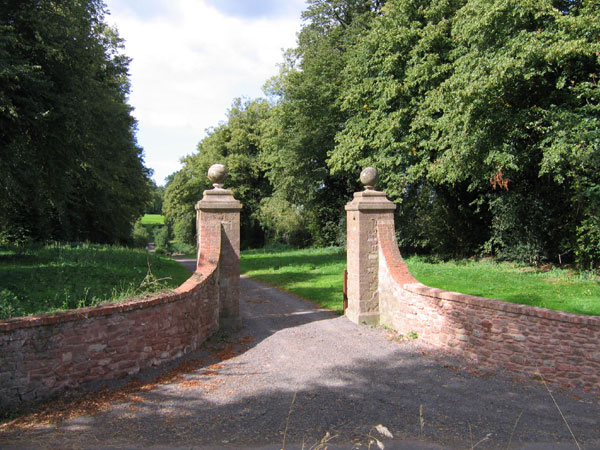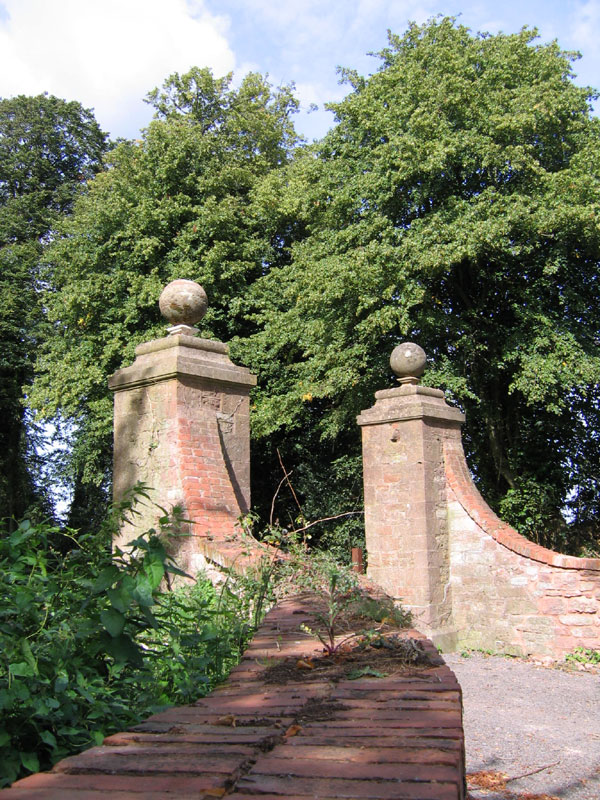AVENUE OF LIME TREES AT CHIPLEY PARK
The fine avenue of limes at Chipley Park shown below is at ST 1280 2365. The avenue is worth seeing in its own right but has the added interest of being probably composed of direct descendants - possibly even the originals - of plants supplied by the English philosopher John Locke. Locke was a personal friend of the Clarke family and frequent visitor at Chipley where, indeed, there were rooms kept always in readiness for him. The Clarkes were a local family and Edward Clarke built the original house at Chipley Park in the late 1680s. It was demolished by the family around 1840.

There are many letters from John Locke to the Clarkes - not only to Edward, but also to his wife Mary and occasionally to the children. Locke's opinion and advice was sought by both Edward and Mary Clarke on everything from the health and education of their family to the reformation of the currency. Indeed, the Clarkes' children may have played their own empirical part in the gestation of Locke's 'Essay Concerning Human Understanding' [published in 1690] as advice on their upbringing was unstintingly given throughout the 1680s and beyond. 'Some Thoughts Concerning Education' [1693] arose directly from the considerable correspondence between Locke and the Clarkes about the education upbringing of their children and the book was dedicated to Edward Clarke.

It is hardly to be wondered at therefore that Locke's advice would be sought on the design and construction of the house and gardens at Chipley. During the early building Locke was in exile in Holland following the debacle of Monmouth's Rebellion, fomented by his master, Lord Shaftesbury, and in which Locke was also implicated. While in Holland Locke was known, appositely, as Dr Van der Linden and had access to botanical skills and knowledge that were seemingly less readily obtainable in England. From Holland he sent the Clarkes all manner of seeds and plants including those for an avenue of limes. Whether the currently existing [2009] avenue consists of those originally planted I am not sure. They are certainly very large, mature trees. While the original house was demolished around 1840, the present avenue is certainly on the site of the original.

The following extracts are principally from letters written by John Locke to Edward Clarke and are taken from 'The Life and Correspondence of Edward Clarke of Chipley 1650-1710' by Bridget Clarke, the whole of which is published on this website through the generosity of the author. The dates below are those used in the originals; for more about that see under 'CLARKE'.

John Locke to Edward Clarke 17 March 1683/84
I have since thy last inquired most particularly of a very skilful man concerning abele [Populus alba] and lime trees. He tells me of the abele trees there is but one sort, and in them you cannot be mistaken. Of lime trees there be two sorts, but the best is that which they call the female lime tree. It is that which bears the flowers, and the bark looks a little reddish and is not altogether so sad as the other. The offsets from the roots will grow. If I can light of any here in time enough I will send you some by a ship that is going hence for Exeter, which I conclude will be much more convenient than London and all the long cartage by land. I have not yet got the lime seeds which were promised me, for our highways, that is rivers and canals, are scarce yet quite open. And now I consider you in the country I can not but be talking to you of those innocent designs of building houses and planning walks: the latter is my theme at present. I desire you to make your walks broad enough, that is, let the bodies of the trees stand in two lines twenty foot in each side wider than the outside walls of your house, and then another row on the outside those twenty further. On the front I think lime trees would do best, on the east side elms, and on the north witch elms, which is a better sort of trees than we commonly imagine. So much at present for walks.
John Locke to Edward Clarke 6th Feb 1685
Now we are come to discourse of trees again. I cannot forbear to repeat what I think I mentioned formerly, that is, to be sure to set the inmost row of the trees that lead to your house on either side twenty foot from the line of your house: this will be much the best when the trees are grown up. And if you think it will be a fault to look along your walk by the side of your house in the meantime, that I think will be cured by planting one tree at the end of the walk next your house, just in the line of your house. I do not approve abeles for walks up to your house: they will do better down about your ponds and by the brook's side. The walks leading to your house on the four sides I would have of those four sorts; lime on the front and on the three other sides, oaks on one, elms on the other, and witch elms on the third as you like best. And for winter trees, if you will be ruled by me, use none but ewe and holly. They will make hedges or standards as you please, will indure any cutting or weather whereas all others as phylyrea, alaternus, cypresses etc are commonly one in twenty years cut down to the ground by a severe winter; examine the garden, and see how many of them were left last summer.
John Locke to Edward Clarke 12/22 March 1684/85
The seeds I hope you have ere this, but the trees we are very unlucky in, for when I believed them at Exeter I received a note that told me that they were not to be got where I was ought I know, so charm me, that perhaps by that time will have his promised them. I presently sought the nurseries here, where I found none but what were a little above the size you desired and infinitely above the price I expected, for they stood upon eighteen pence apiece for such as were about the bigness of one's thumb or a little bigger. I was loath to give £15 sterling for 200 lime tree plants, which considering the lateness of the season and the uncertainty to meet with an Exeter ship ready to sail presently, 'twas odds would not grow one of them, if any at all. I advise you to furnish yourself among the gardeners and seedsmen in and about London with the seeds. In the meantime pray send word what price such lime-tree plants bear in England for I imagine it was but the cheating stranger's price that they asked me.
John Locke to Edward Clarke 31st October 1686
But to return to the abele trees, pray what do you mean by so great a number of them? It is true they are quickly up, but what are they good for when grown? If you cannot learn that the timber is good for something, I advise you to plant no more of them than you have need of for some present shade or shelter. In a rich soil like yours where all things grow so well, I should choose to have a walk up to the front of the house of limes only for beauty, two rows of a side, and a space between them as broad as the front of your house, or ten or fifteen foot broader, as I formerly told you. But behind the house I would have a walk of the same fashion of elms, and on the sides of other useful trees (perhaps oak should be one) which will serve for beauty and use too, and pay for their standing.
John Locke to Edward Clarke 9/19 October 1688
In hopes, therefore of your healths and good stomachs I have been just now taking care about your garden belly timber, since Madame has been pleased to value them of this country so much. I have therefore bought winter turnip seeds 3vi, summer turnip seeds 3vi, yellow turnip seeds 3vi, carrot seeds 3vi, red cabbage seeds 3iii, and lime tree seeds as much as all the other together. I have now taken the first of the season to provide them to make some amends for my tardiness last year, and you may expect them time enough to try some of them yet this season if the wind hinder not, for the vessel they are designed by waits for nothing else. I am very glad your gardener was so well pleased with what was to be got for him whilst you were here. The truth is the nasturtium indicum, with that brave large glorious flower, is an excellent plant both for show and use. I hope the seeds though of the last year will grow.
Edward Clarke to John Locke Chipley 24 October 1688
The turnip-seeds, carrot-seeds and redcabbage seeds will be verie welcome to the people in the kitchen, as well as the gardener, whenever they come. But the lime-tree seeds will be as much more esteemed by me, as I value a good plantation of timber and of beautiful trees beyond any belly tymber whatsoever; the one if taken sufficient care of when first planted being a good provision for posterity, and the other only serves as to please the palate and destroy hunger.

